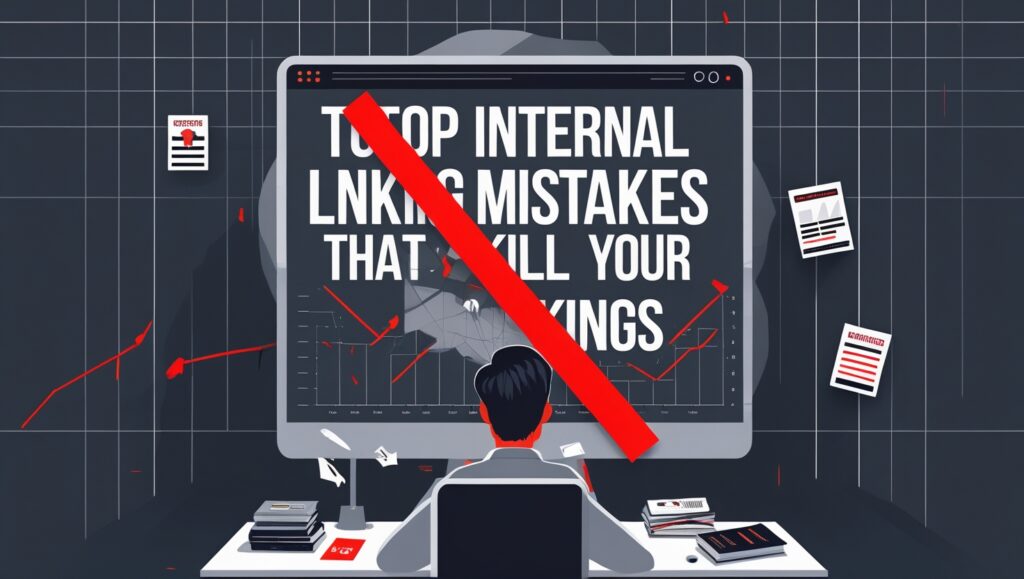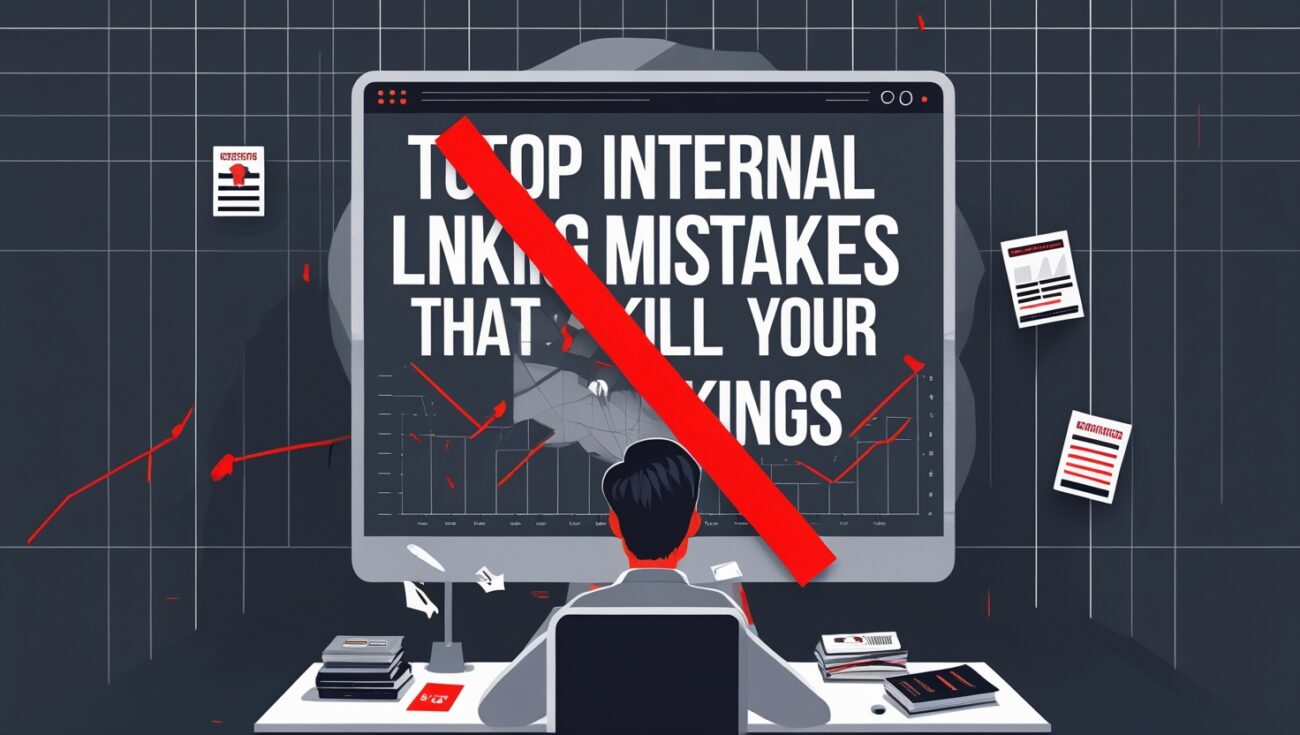Top Internal Linking Mistakes That Kill Your Rankings
I’ve learned that in SEO, what you don’t do can be just as important as what you do. While internal linking is one of the most powerful and foundational SEO tactics you have complete control over, it’s also surprisingly easy to get wrong.
I’ve personally made many of these mistakes on my own websites, and I’ve seen firsthand how they can quietly sabotage your rankings, even when you’re doing everything else right.

Table of Contents
The truth is, a poorly executed internal linking strategy can create confusion for both search engine crawlers and your users. Instead of building authority and improving visibility, you end up creating a mess that hurts your website’s performance. Let me walk you through the top internal linking mistakes I’ve seen—and how to fix them for good.
Mistake 1: Ignoring Orphaned Pages
This is, by far, the most common and damaging mistake. An orphaned page is a page on your website that has no incoming internal links from any other page on your site. These pages are invisible to search engine crawlers and can’t receive any valuable link equity. You might have a brilliant, high-quality article, but if it’s an orphan, it will sit in the shadows, unable to rank. I highly recommend using a tool like Linkbot to easily find all of your orphaned pages.
Mistake 2: Using Generic and Unhelpful Anchor Text
The anchor text—the clickable words of your link—is a crucial signal for both users and search engines. A major mistake is using generic phrases like “click here,” “learn more,” or “read this.” This is a huge missed opportunity to signal what the destination page is about. Good anchor text is descriptive, relevant, and helps users understand what to expect before they click.
Mistake 3: Linking to Irrelevant Content
Every single internal link you create should have a purpose. A common mistake is adding links just for the sake of it, without considering their relevance. Linking an article about “business marketing” to a page about “pet grooming services” is not only confusing for the user but also sends a jumbled signal to Google. It dilutes your topical authority and can actually harm your rankings.
Mistake 4: Over-Optimizing Your Anchor Text
On the other end of the spectrum from generic anchor text is the mistake of over-optimization. This happens when you use the exact same keyword-rich phrase over and over for every link to a specific page. For example, if you link to your “SEO services” page using the exact anchor text “SEO services” 50 times, it can look unnatural and spammy to Google’s algorithm, potentially leading to a penalty.
Mistake 5: Failing to Audit Your Links
Your website’s internal link profile is a living, breathing thing. A page that was once valuable might have been deleted, creating a broken link that leads to nowhere. New content you add might become an orphan. Failing to regularly audit your site for broken links and orphaned pages is a major mistake that will silently kill your rankings over time. I use Linkbot to audit my internal link profile, and it saves me countless hours.
Mistake 6: Not Linking from High-Authority Pages
You can’t just link from any page to a new one and expect a huge boost. A common mistake is not leveraging your most authoritative pages—the ones that already rank well or have a lot of backlinks. These “hubs” are the pages with the most link equity to share, and failing to use them to promote your most important content is a critical error.
Conclusion: Stop Killing Your SEO and Start Fixing Your Links
The good news is that these mistakes are all within your control. By avoiding these common pitfalls and adopting a more strategic approach, you can transform your internal linking from a source of problems into a powerful asset. By proactively finding and fixing these issues, you can significantly improve your website’s crawlability, authority, and overall visibility.
Don’t let these simple mistakes sabotage your hard work. Take control of your site’s SEO from the inside out and build a clean, logical, and powerful internal link profile. Start fixing your internal linking mistakes and take control of your SEO with Linkbot today.
Beyond the technical side, a website filled with these internal linking mistakes also feels less trustworthy to a user. When a visitor clicks a link and it leads to an irrelevant page or a broken link, it immediately erodes their confidence in your brand. A professional, well-maintained website signals quality and expertise, which are key components of building a loyal audience.
These mistakes can also have a negative impact on your crawl budget. Google’s crawlers have a limited amount of time they are willing to spend on your site. When they encounter broken links, or get lost in a network of orphaned pages, they are wasting valuable time that could be spent indexing your important content. A messy internal link profile essentially makes your site a hassle for search engines to navigate.
The long-term, compounding effect of these mistakes is what truly makes them so costly. Each broken link or orphaned page represents a leak in your SEO foundation. Over time, these leaks add up, and your site’s authority begins to slowly seep away. Fixing these issues isn’t just a temporary boost; it’s an essential long-term investment in your site’s health and longevity.
I can say from personal experience that there is a special kind of satisfaction that comes from cleaning up a messy internal link profile. It’s the feeling of taking a tangled mess of wires and organizing them into a clean, logical network. The result is a website that just feels better to navigate, for both users and the people managing it.
My journey taught me that a major mistake is thinking of links as just “votes.” While they do pass authority, they are more accurately signals of relevance. A link from a page about “business accounting” to a page about “business loans” is more than a vote; it’s a signal that these two pages are topically related, and that your website is a comprehensive resource on the subject.
One of the greatest benefits of using an automated tool to fix these mistakes is the “to-do” list it provides. Instead of being overwhelmed by a massive report, a good tool will give you an actionable list of fixes to make. It transforms a monumental, frustrating task into a series of manageable steps that you can tackle in minutes.
A common mistake I’ve seen is linking to a new page from a website’s homepage, thinking that’s the best way to pass authority. While a homepage link is powerful, a link from a deep, highly relevant blog post with a specific anchor text is often more valuable. The context of the link is a critical signal that you lose when you only link from a general hub like your homepage.
It’s crucial to understand that a clean site structure is not the same as having a bunch of category pages. A simple category page groups articles, but a strong internal linking strategy involves creating thoughtful connections within the content itself. This intentional, contextual linking is what truly helps Google understand your site’s hierarchy and topical authority.
The most important part of this foundational skill is building a consistent habit of reviewing your links. It’s not about a single audit and then forgetting about it. A good website is a living thing, and it needs regular maintenance to prevent broken links and orphaned pages from silently undermining your hard work.
My own journey taught me that by mastering my internal links, I was finally in the driver’s seat of my SEO. I was proactively building my site’s authority from the inside out, on my own terms, which was an empowering and exciting feeling. I stopped relying on external factors and started building my own SEO foundation.
Ultimately, these internal linking mistakes are so costly because they are so easy to make. They happen quietly and can undermine years of content creation and SEO efforts. By taking the time to understand and avoid them, you can build a strong, resilient website that will continue to perform for years to come.
I’ll never forget the first time I fixed a few internal links on a page that was struggling to rank, and it shot up in the search results almost overnight. It was at that moment I realized that sometimes, the biggest problems have the simplest solutions, and that a clean internal link profile is the most powerful tool a website owner can have.

